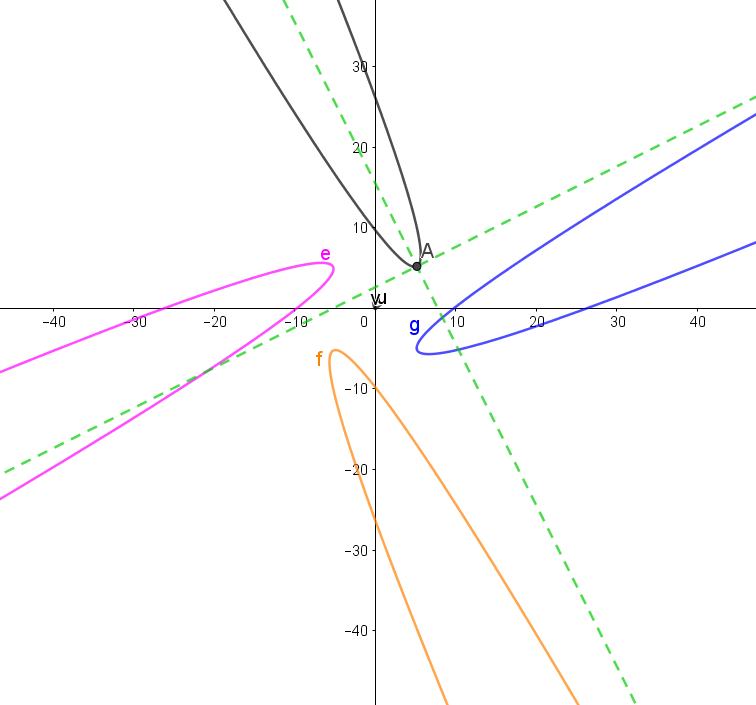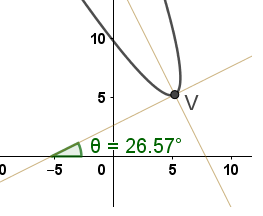Conic Rotation
We have already covered equation rotation. What we haven't explicitly done is show a general form for a conic. In particular we will be discussing the ellipse, the parabola, and the hyperbola as drawn in the $xy$ plane. All three have the following general form. $$Ax^{2}+Bxy+Cy^{2}+Dx+Ey+F=0 \tag{1} \label{1}$$ We will have more to say about this equation very soon. Right now we just want to know that it will often graph as one of these three curves. Yet, as we discuss these curves, we will find that much of the information that can be obtained from their equations is only available when there is no $xy$ term. If the $xy$ term exists, then the conic is not aligned with the axes. The coefficient of the $xy$ term is $B$. When not rotated, $B=0$. Another way to say this; if a conic is aligned with either the $x$-axis or the $y$-axis, then there is no $xy$ term.
Before we get too carried away, let's just remind ourselves that just because an equation has the form of $\eqref{1}$ is no guarantee that it is a parabola, hyperbola or ellipse. For example: $$2x^{2}-3xy+y^{2}+12x-9y=-18$$ is actually just two straight lines. Usually, a graphing calculator sketch of the equation will be enough to tell the difference. If not, there are more advanced methods to identify these degenerate conics. In the case shown, it can be factored into $(x-y+3)(2x-y+6)=0$. It may be hard to spot the factors and graphing might help by allowing you to find the equation of the lines.
So, if we are sure that the conic is a hyperbola, parabola or ellipse, then there is a test that can tell us which conic equation we are dealing with. The explanation will come later. For now let's just look at the test. Given the coefficients as defined in $\eqref{1}$, $$\begin{split} \text{Hyperbola } &B^{2}-4AC>0\\ \text{Parabola } &B^{2}-4AC=0\\ \text{Ellipse } &B^{2}-4AC<0 \end{split}$$
Rotation
Here is our conic: $$Ax^{2}+Bxy+Cy^{2}+Dx+Ey+F=0$$ How much is it rotated? Given the information that we have so far, that is a poorly formed question. It doesn't specify a starting point. A better question is how much would we have to rotate this conic to get it aligned with the axis.
Here we just show the answer! Later we will show how it can be derived. $$\cot(2\theta)=\frac{cos(2\theta)}{sin(2\theta)}=\frac{A-C}{B} \tag{2} \label{2}$$ What if $B=0$, then the conic must be aligned with either the $x$ or $y$ axis, although that still leaves four orientation possibilities. For the ellipse and hyperbola, pointing up down and east west are not easy to distinguish, but for the parabola it is obvious.
Caution: When we solve for $\theta$, we will get one of four possible angles. The best idea is to sketch the curve and, having converted the angles into degrees, look to see if that is the amount of rotation desired. If not, adjust the angle, $\theta$, by $\pi/2$ until we get what is wanted.
We could also describe the angle as a direction vector, and that is exactly what an eigenvector does. We will do that soon, but not now.
Answer: Using equation $\eqref{2}$, $$\frac{\cos(2\theta)}{\sin(2\theta)}=\frac{1-\frac{1}{4}}{1}=\frac{3}{4}$$ $$\theta=k_{1}\frac{\pi}{2}+\frac{1}{2}\arctan\left(\frac{4}{3}\right)\approx26.57^{\circ}$$ $k_{1}$ can be any integer.

We might expect that the parabola would be tilted $\sim26$ degrees off of the x-axis, since in math we tend to measure everything counter-clockwise from the x-axis, but if we graph it, we see that it is $90^{\circ}+26.57^{\circ}$ which is consistent with the angle we found, since it is mod $\pi/2$.
